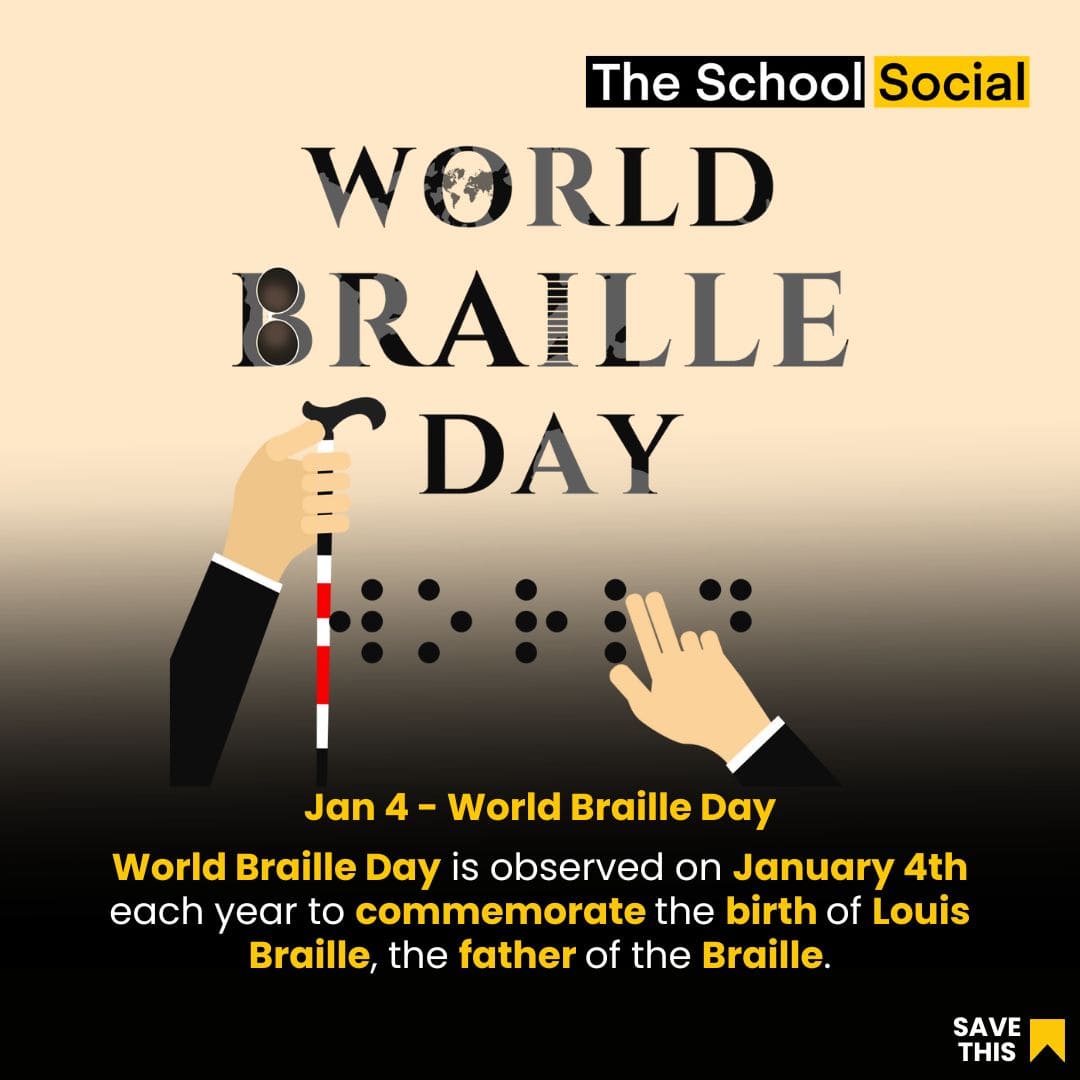4th January - World Braille Day
World Braille Day is observed on January 4th each year. This day commemorates the birthday of Louis Braille, the inventor of Braille, a tactile reading and writing system used by people who are blind or visually impaired. Louis Braille was born on January 4, 1809, in France.
World Braille Day is an opportunity to raise awareness about the importance of Braille in promoting equal access to information and education for individuals with visual disabilities. It also serves as a reminder of the ongoing need for accessible materials and technologies to support the inclusion of people who are blind or visually impaired in various aspects of life.
What is interesting about World Braille Day?
Facts about braille for World Braille Day 2023
This day celebrates the birthday of Louis Braille, the inventor of the Braille system. Louis Braille's invention has had a profound impact on the lives of blind and visually impaired individuals, providing them with a means to read and write independently.
World Braille Day highlights the importance of creating an inclusive and accessible world for people with visual disabilities. It serves as a reminder that access to information and education is a fundamental right for everyone, regardless of their abilities.
This day serves as a platform to raise awareness about the challenges faced by blind and visually impaired individuals and the significance of Braille in overcoming these challenges. It encourages conversations about the importance of providing accessible materials and technologies.
World Braille Day advocates for Braille literacy and emphasizes the need for educational institutions and organizations to incorporate Braille into their programs. This literacy is crucial for the independence and empowerment of individuals with visual impairments.
World Braille Day is observed worldwide, bringing attention to the importance of Braille on an international scale. It provides an opportunity for global collaboration and cooperation in promoting the rights and well-being of people with visual disabilities.
What is the history of braille?
Louis Braille's remarkable invention of the Braille system at the young age of 15 has had a lasting impact on the lives of millions of visually impaired individuals around the world. Louis Braille was born on January 4, 1809, in Coupvray, France. At the age of three, he accidentally injured his eye with a tool from his father's workshop, resulting in an infection that eventually left him blind in both eyes.
Despite his blindness, Louis Braille was determined to overcome the challenges associated with visual impairment. In 1824, while still a teenager, he developed the Braille system as a method of communication and literacy for the blind.
Louis Braille's legacy is celebrated not only on World Braille Day but throughout the year, as his invention continues to empower visually impaired individuals by providing them with a means to navigate the world of literature, education, and communication.

When did Charles Barbier invent night writing?
Louis Braille was inspired by a military code called "night writing" developed by Charles Barbier, a French army officer, in 1819. Barbier created this code as a means for soldiers to communicate silently and without light during the night, allowing them to exchange information on the battlefield without giving away their positions.
Barbier's "night writing" system used a set of 12 embossed dots arranged in two columns, representing phonetic sounds rather than letters. While the military code proved to be impractical for soldiers, it planted the seed for the development.
Louis Braille's ingenious modifications transformed Barbier's military code into a revolutionary and accessible reading and writing system for the blind, opening up new avenues for education, communication, and literacy among visually impaired individuals.
Louis Braille encountered Charles Barbier's night writing system in 1821 when he was a student at the Royal Institution for Blind Youth in Paris. Recognizing the potential of Barbier's system to improve communication for the blind, the young Louis Braille set out to simplify and adapt the code. By 1824, at the age of 15, Louis Braille had refined and developed the Braille system we know today. He reduced the number of dots from Barbier's original 12 to 6, creating a more efficient and practical tactile code for representing letters, numbers, and punctuation marks. Braille's system allowed blind and visually impaired individuals to read and write with their fingertips, providing a revolutionary method for literacy and communication. Louis Braille's adaptation of Barbier's night writing system marked a significant breakthrough in making written information accessible to the blind, and his legacy continues to impact the lives of millions worldwide.
What is the literacy rate of braille?
According to 2023 reports, the rates of Braille literacy are distressingly low, with only approximately 1% of the population in India and 5-10% in developed countries possessing proficiency in this vital skill.
Braille literacy is crucial for the education and independence of blind and visually impaired individuals, providing them with a means to access written information and communicate effectively.
What is the technology in braille?
Technological progress has rendered Braille more accessible than ever before. Through the development of Braille displays and Braille-enabled devices, technology is positively impacting the lives of individuals with visual impairments.
Braille technology refers to assistive technology that enables individuals who are blind or visually impaired to electronically read, write, or manipulate Braille.
When was World Braille Day annually observed by United Nations?
In November 2018, the United Nations General Assembly decided to designate January 4th as World Braille Day. This acknowledgment reflects the understanding that the complete realization of human rights and fundamental freedoms depends on the promotion of inclusive written communication.
How is braille important in everyday life?
Braille is crucial in everyday life for individuals who are blind or visually impaired. Braille has become ubiquitous in various aspects of daily life, from elevator buttons to medication packaging, empowering visually impaired individuals with a sense of independence. These features promote autonomy in tasks such as navigation, banking, and information access, thereby fostering equality and accessibility in our diverse world.








